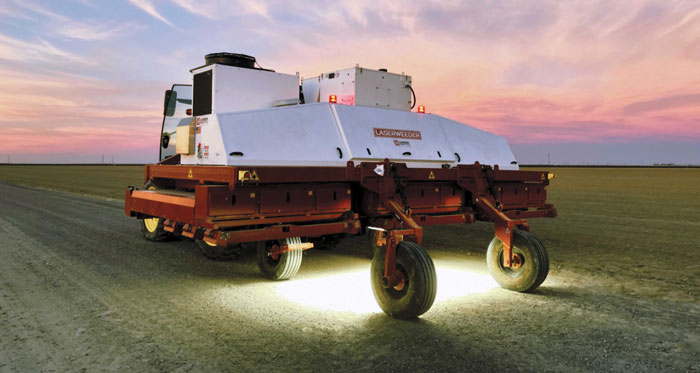We had a good conversation recently with Paul Mikesell, CEO of Carbon Robotics, the Seattle-based tech firm which began selling its pull-behind LaserWeeder in 2021, about the economic and environmental benefits of the popular precision machine.
To recap, the LaserWeeder is a computer-driven laser “weed gunship” that uses artificial intelligence to recognize and destroy weeds, leaving adjacent high-value crop plants unharmed — all the while moving through the field at nearly comparable speeds of boom applicators. The machine carries a PTO-powered generator to energize rotating laser turrets that lock-on to weed species and destroy them with heat energy.
Videos taken from the business end of the LaserWeeder at work show weeds bursting into flashes of ash and wilting amid healthy, thriving crop plants.
Mikesell says the current 20-foot-wide machines work with 60-84 inch row spacing and can eliminate using hand labor in the field to pull weeds, while at the same time replace expensive regulation-laden herbicide use.
“The machine can operate to within a millimeter of crop plants, eliminating the collateral damage of rotating blades found on other mechanical weeders,” he explains.
Mikesell says his company is currently fulfilling orders for LaserWeeders bound for more than 50 farms mainly in the Western U.S. and Canada and is looking forward to international sales for the 2024 crop year. He says initial orders are going to vegetable and other specialty-crop producers in California, Washington, Arizona and New Mexico but says Carbon Robotics will be expanding its sales rapidly into Idaho, Oregon and Colorado, as well as to farms on the U.S. East Coast.
“We’re focused on crops like onions, broccoli, cauliflower, carrots, lettuce, leafy greens, spinach, cucumbers, leeks and garlic. Everything you eat directly out of the vegetable and herb aisle at the grocery store,” he explains. “Right now, that’s where the LaserWeeder performs best.”
Economics is driving the interest in the LaserWeeder, and Mikesell says the machine can pay for itself in 1-3 years in reduced labor and herbicide-related costs.
“Some of the best examples from our customers indicate reductions in weed control bills of 80%,” he says.
“The biggest issue for most growers today seems to be labor and access to labor, so the last thing I think you want to do is put your crews to work pulling weeds. It’s a waste of abilities and time, so getting a machine to take care of that is an important money saver,” he explains. “Also, laser weeding requires no field inputs such as herbicides, plus there’s no concern over wind conditions or downstream drift.”
Mikesell says many herbicides are gradually losing their effectiveness and studies show generally herbicide use has negative effects on cash crops not seen with mechanical (or electrical) weeding.

The LaserWeeder by Carbon Robotics is in full production with orders pending from more than 50 U.S. and Canadian farms. The machine, which can operate up to 84-inches uses machine vision and heat energy from focused and targeting lasers in all conditions to destroy weeds without chemicals or hand-labor. Image Carbon Robotics
“We have a lot of examples of herbicide-treated crops compared with laser-weeded crops, and the latter will come up earlier and just generally be happier,” he says.
While broad-acre commodity row crops have so-far not been the target of Carbon Robotics, the technology seems to offer an excellent opportunity to deal with weeds throughout U.S. farm country. It’s not difficult to imagine the effect of laser energy on young Palmer amaranth and marestail plants — which are showing tougher genetic defenses to both broad-spectrum and selective herbicides.
Growers in the Corn Belt, the Mississippi Delta and the Great Plains need to put the pencil to laser weeding as they observe the results seen in specialty crops.
Mikesell suggests environmental concerns (including the economics of meeting or failing to meet them) as well as overall crop production economic factors should be considered when exploring the possibility of using laser weeding in traditional row-crop operations.
As it stands now, however, Mikesell says Carbon Robotics continues to refine its product to include a “thinning mode” to its operating system. This will allow growers to weed their high-value crops, while at the same time allowing the machine to visualize, measure and thin areas of over-planting to optimum plant spacing for further productivity boosts.
“We already have the lasers that recognize and kill plant matter, so we’re upgrading our computer vision to be able to detect not just the weeds, but the crops and the configuration of the crops and how closely they are growing to one another,” he says. “With that capability we can provide optimal spacing, thinning while we weed.”






